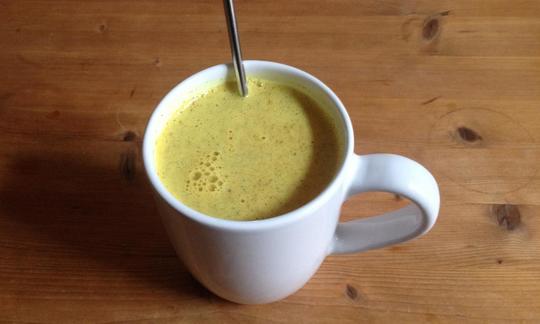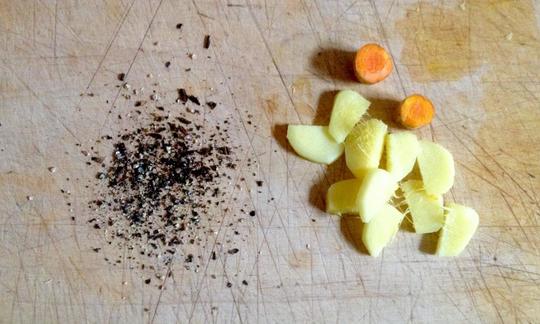Warming Raw Energy Drink with Ginger and Turmeric
raw-vegan
Ingredients (for serving, )
| For the energy drink base | |
|---|---|
| ¼ oz | Ginger, raw (organic?) |
| oz | Turmeric, fresh (raw, organic?) |
| 200 ml | Drinking water, raw (organic?) (7.0 oz) |
| 1 ½ tbsp | Honey (bee honey, raw?, organic?) (1.1 oz) |
| 1 tsp | Coconut oil (coconut oil, coconut fat, organic?, raw?) (0.16 oz) |
| ½ tsp | Vanilla powder (ground vanilla, organic?) (0.04 oz) |
| 1 dash | Black pepper (organic?, raw?) (0.00 oz) |
| For the finished beverage | |
| 50 ml | Drinking water, raw (organic?) (1.8 oz) |
Equipment
- blender or hand-held blender / immersion blender
Type of preparation
- chop or grind
- food preparation without heating
- blend
- peel
Preparation
For the energy drink base
Peel the ginger and cut into small pieces. Rinse off the turmeric. Put both in a blender and pour in the fresh, cold water.It works best to peel ginger using the sharp outer edge of a spoon. With the inverted spoon, you can scrape off only the brown skin and none of the inner yellow part is wasted.
Add the honey, coconut oil, ground vanilla, and freshly ground black pepper.
Blend for at least one minute or until ginger and turmeric are well pulverized and the mixture takes on a smooth consistency and an even yellow color.
The exact blending time will depend on the type and quality of the blender. With a high-performance appliance, it should only take a minute, but it can take longer if you are using an immersion blender.
For the finished beverage
Pour the finished energy drink base into a cup or a glass and dilute with hot water.
|
Nutritional Information per person
Convert per 100g
|
2000 kcal | |
|---|---|---|
| Energy | 145 kcal | 7.2% |
| Fat/Lipids | 4.5 g | 6.5% |
| Saturated Fats | 3.7 g | 18.7% |
| Carbohydrates (inc.dietary fiber) | 28 g | 10.4% |
| Sugars | 27 g | 29.5% |
| Fiber | 0.48 g | 1.9% |
| Protein/Albumin | 0.27 g | 0.5% |
| Cooking Salt (Na:12.8 mg) | 32 mg | 1.4% |
| Essential micronutrients with the highest proportions | per person | 2000 kcal | |
|---|---|---|---|
| Min | Copper, Cu | 0.06 mg | 6.0% |
| Min | Manganese, Mn | 0.13 mg | 6.0% |
| Min | Fluorine, F | 180 µg | 5.0% |
| Min | Iron, Fe | 0.58 mg | 4.0% |
| Elem | Calcium, Ca | 23 mg | 3.0% |
| Elem | Magnesium, Mg | 7.1 mg | 2.0% |
| Elem | Potassium, K | 48 mg | 2.0% |
| Sodium, Na | 13 mg | 2.0% | |
| Elem | Phosphorus, P | 4.1 mg | 1.0% |
| Min | Zinc, Zn | 0.15 mg | 1.0% |
Detailed Nutritional Information per Person for this Recipe
The majority of the nutritional information comes from the USDA (US Department of Agriculture). This means that the information for natural products is often incomplete or only given within broader categories, whereas in most cases products made from these have more complete information displayed.
If we take flaxseed, for example, the important essential amino acid ALA (omega-3) is only included in an overarching category whereas for flaxseed oil ALA is listed specifically. In time, we will be able to change this, but it will require a lot of work. An “i” appears behind ingredients that have been adjusted and an explanation appears when you hover over this symbol.
For Erb Muesli, the original calculations resulted in 48 % of the daily requirement of ALA — but with the correction, we see that the muesli actually covers >100 % of the necessary recommendation for the omega-3 fatty acid ALA. Our goal is to eventually be able to compare the nutritional value of our recipes with those that are used in conventional western lifestyles.
| Essential fatty acids | per person | 2000 kcal |
|---|---|---|
| Linoleic acid; LA; 18:2 omega-6 | 0.09 g | 1.0% |
| Alpha-Linolenic acid; ALA; 18:3 omega-3 | 0.00 g | < 0.1% |
| Essential amino acids | per person | 2000 kcal |
|---|---|---|
| Leucine (Leu, L) | 0.01 g | 1.0% |
| Valine (Val, V) | 0.01 g | 1.0% |
| Tryptophan (Trp, W) | 0.00 g | 1.0% |
| Threonine (Thr, T) | 0.01 g | 1.0% |
| Isoleucine (Ile, I) | 0.01 g | 1.0% |
| Phenylalanine (Phe, F) | 0.01 g | 1.0% |
| Lysine (Lys, K) | 0.01 g | < 0.1% |
| Methionine (Met, M) | 0.00 g | < 0.1% |
| Vitamins | per person | 2000 kcal |
|---|---|---|
| Niacin (née vitamin B3) | 0.10 mg | 1.0% |
| Pantothenic acid (vitamin B5) | 0.04 mg | 1.0% |
| Vitamin C (ascorbic acid) | 0.56 mg | 1.0% |
| Riboflavin (vitamin B2) | 0.02 mg | 1.0% |
| Vitamin B6 (pyridoxine) | 0.02 mg | 1.0% |
| Folate, as the active form of folic acid (née vitamin B9 and | 1.3 µg | 1.0% |
| Thiamine (vitamin B1) | 0.00 mg | < 0.1% |
| Vitamin A, as RAE | 0.11 µg | < 0.1% |
| Vitamin E, as a-TEs | 0.02 mg | < 0.1% |
| Vitamin K | 0.20 µg | < 0.1% |
| Essential macroelements (macronutrients) | per person | 2000 kcal |
|---|---|---|
| Calcium, Ca | 23 mg | 3.0% |
| Magnesium, Mg | 7.1 mg | 2.0% |
| Potassium, K | 48 mg | 2.0% |
| Sodium, Na | 13 mg | 2.0% |
| Phosphorus, P | 4.1 mg | 1.0% |
| Essential trace elements (micronutrients) | per person | 2000 kcal |
|---|---|---|
| Copper, Cu | 0.06 mg | 6.0% |
| Manganese, Mn | 0.13 mg | 6.0% |
| Fluorine, F | 180 µg | 5.0% |
| Iron, Fe | 0.58 mg | 4.0% |
| Zinc, Zn | 0.15 mg | 1.0% |
| Selenium, Se | 0.30 µg | 1.0% |
| Iod, I (Jod, J) | 0.40 µg | < 0.1% |
This warm, raw energy drink with ginger and turmeric comes as a welcome warm-up on cool days. Its ingredients promote healthy blood circulation and metabolism.
Ginger: Ginger not only warms us from the inside, but the organic compounds it contains also stimulate our blood circulation. Its metabolism-stimulating properties are used to alleviate digestion problems, nausea, and dizziness. The active ingredient gingerol is responsible for ginger’s effects on the body, and this compound also contributes to its characteristic strong, spicy taste.
Be careful if you grind the turmeric yourself: Turmeric colors everything yellow, including the blender, so you should be careful if you prepare it on surfaces that are easy to stain. The root is native to South Asia and is still used there frequently.
Curcumin, one of the sources of turmeric’s brilliant orangish yellow color, offers many health benefits. These include cancer and anti-inflammatory properties as well as antioxidative potential. There are also indications that turmeric has a positive effect on bones and on psychological well-being (as an antidepressant). In addition to these factors that contribute to our physical health, the sunny yellow color also makes this drink ideal for the cool gray seasons. Because of its color, curcumin is also used as an E100 food additive for coloring various foods such as margarine or mustard.
Honey: We use real honey in this recipe. Honey is considered raw as long as it is produced using cold extraction methods such as cold spinning and filtration. If honey is stored or processed at temperatures over 40 degrees Celsius, the high temperatures reduce important heat-sensitive compounds that are otherwise present in unheated honey. The way honey is stored and processed also affects its quality, especially its ratio of fructose to glucose. For more information, see the ingredient honey.
Vanilla: Ground vanilla can be used as an alternative to vanilla beans. However, the ground vanilla that is available commercially has a weaker vanilla flavor than whole vanilla bean pods do. Vanilla extract is different. Vanilla extract is a liquid extract of vanilla in a highly concentrated form with about 35 % ethanol. Pure vanilla extract is always made from real vanilla beans.
Coconut oil: If you do not use oil in your diet, you can simply omit the coconut oil. But by acting as a carrier oil, it does enhance the development of the drink’s aroma and flavor.
Alternative to honey: For a completely vegan alternative, you can use agave syrup, maple syrup, or dandelion honey.
Spices: Depending on your taste, you can also use other spices in addition to the pepper, such as a pinch of curry or paprika.






